
© Laurent Liotardo. (Click image for larger version)
New Movement Collective
Project XO Remote – Wearable Robotics – An online interactive installation
5-8 June 2021
Music and sound design: Olga Wojciechowska
Producer: Malgorzata Dzierzon
Creative technologists: Jon Rowe, Simon Haenggi, Kai Lab and Fenyce Workspace
Performers: Malgorzata Dzierzon, Patricia Okenwa, Alexander Whitley and Renaud Wiser.
newmovement.org.uk/works/project-xo
I look at my laptop screen – transfixed by the robot/human I am about to manipulate, nervous to be in this role of choreographer and so remote. I’m instructed to tap on a variety of buttons which appear at the bottom of the screen – they contain symbols that look like Benesch dance notation. This way I can mobilise the arms of performer Malgorzata Dzierzon as she sits attached to the metal technology. It’s a strange sight – the performer appears to be gripped by a giant, spider robot which is in fact an exoskeleton suit, a wearable machine. I also have the option to vary the speed at which the cyber suit moves the performer and here I feel I should go gently and slowly so we can both warm up. I have just under 4 minutes to play around and create some moves. No pressure!
In the second 4-minute section, the dancer is released from the robotic suit. This time she responds to my manipulations of the robot unlimited by its confines. Now there are more choreographic possibilities in terms of space, dynamics and quality. Her kinetic space is not limited by the machinery but by the pace at which I press the buttons. Gaining confidence I crank up the speed, initiate rapid changes of direction and quicker responses to the movement possibilities or alternate between slow and fast. Now our interaction becomes more playful and creative and I enjoy the dance conversation that’s unfolding.
New Movement Collective’s interactive, online project Project XO Remote asks many questions not just about wearable technology, what it can do and how it affects both dancer and viewer but also about the responsibility of the spectator. This thinking extends to questions of power, who has it or how is it shared. Performed in a theatrically lit basement studio at Stone Nest in central London, with an atmospheric electronic sound design by Olga Wojciechowska, the aesthetics of the work while industrial and gritty are nevertheless delicate and subtle, a far cry from the aggressive design of sci-fi movies. The culmination of a 4-year research project, the original interactive performance was intended to be shown live at Sadler’s Wells at a digital festival in April 2020, in which audience members would have been invited to experience moving in a exoskeleton suit. NMC are particularly interested in how to work with audiences differently and wanted to focus on what happens when they’re involved in this intensely experiential way; how that might change the behaviour between the spectator and performer in live performance. Project XO Remote came about because of Covid, its cancellation prompted NMC to make a different version that would still involve participants but remotely. Taking advantage of the Zoom boom, where people have gained confidence in operating or participating on digital platforms, provided a good opportunity to experiment with people’s technological confidence. The online experience, like Zoom, also enabled the project to reach out to a much wider audience around the world.

© Laurent Liotardo (photography), Joe Walkling (image design). (Click image for larger version)
Reflecting on what it felt like to control the dancers a number of things come to mind: frustration with not being able to trigger an instant response from the robot and insecurity about not doing it correctly or being creative enough. I also feel slightly exploitative and voyeuristic as I sit at home invisible to the performer who can’t return my gaze. Empathy for both performer and strangely enough for the technology itself makes me cautious with my movement choices – I engage with both robot and human with a mixture of playfulness and caginess. I’m fascinated with how muscles respond to impulses and how that reverberates through the body to create some kind of emotional force, yet I’m not sure what that emotion is. I think about what it must feel like to wear the suit, to give up control to an unseen audience member. Speaking later to performers and producers Malgorzata Dzierzon and Renaud Wiser, they describe how they hardly sense the exoskeletal suit when movement commands are slow but when directed to move fast all of its 20lbs feels like an invasion on the body. They also discuss how difficult yet revealing it is to give up control as dancers and what they learn from this submission on both a physical and emotional level. In the second section where they are freer without the weight of the suit, they rely on responsiveness, curiosity and of course technical skill to react to the robot’s choreography. Although the performers have rehearsed for months with the technology and have an idea about how they will improvise, they can never anticipate fully how each audience member will use the controls. It can be very challenging if participants choose quick or sudden changes of direction but it’s interesting how they can sense the participant through the lens of the camera by the decisions they make!
Project XO Remote is a fascinating project in process that seems to advance the work of for example the performance artist Stelarc who in a cruder way and without the same choreographic focus was doing similar investigations with the human body and robotic technology. What I find intriguing is the balance or tension between participant, technology and performer, where no one actually dominates: while the dancers relinquish control they are still a significant presence; the machinery is tamed by the performer whereas the participant while arguably in a position of power, is vulnerable in their solitude. We look forward to the project’s development and future reincarnations of live and online performances where these questions about dance, the body and technology will be explored further.










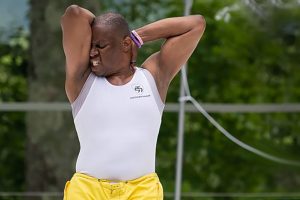

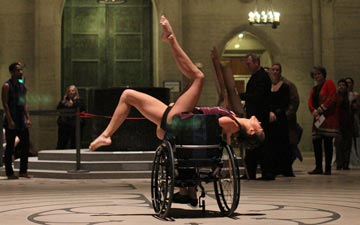
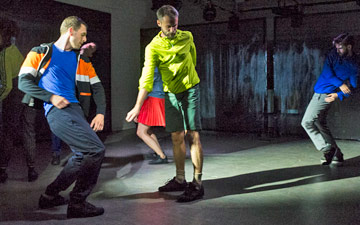
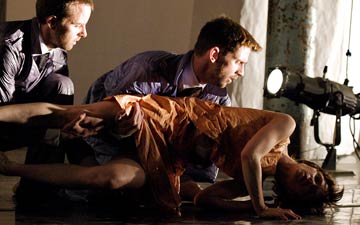

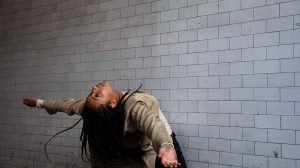
You must be logged in to post a comment.